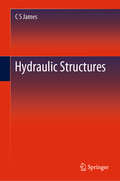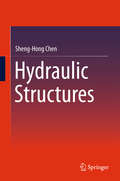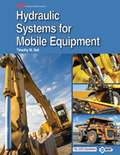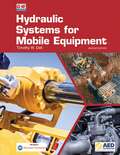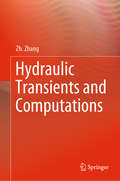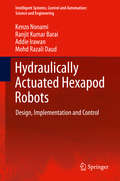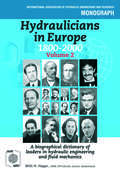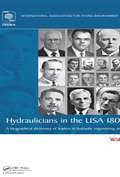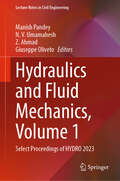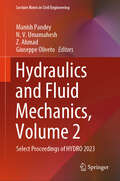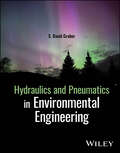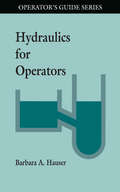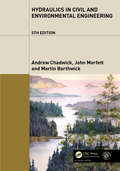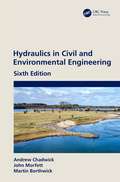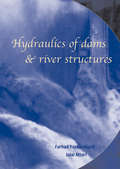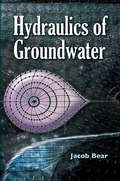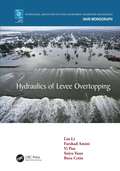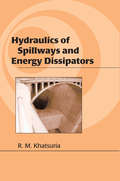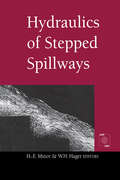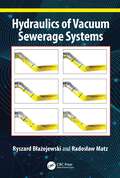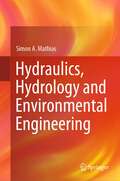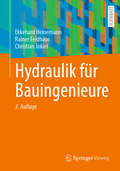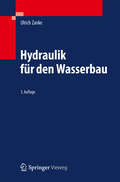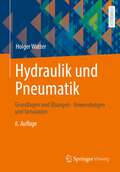- Table View
- List View
Hydraulic Structures
by C S JamesThis graduate/upper-division undergraduate textbook provides a solid grounding in the theory underlying the design and analysis of hydraulic structures, including spillways, energy dissipators, culverts, flow measuring structures and others. It describes well-established theory and procedures, as well as recent developments gleaned from the research literature, with a design-oriented perspective. Professor James provides all of the necessary detail for many practical design applications, while retaining a concise presentation, with ample references to many comprehensive supplementary design guides. Appropriate for upper-level undergraduate and graduate civil engineering student and practitioners in the field, the book fosters an understanding of and competence in applying basic theoretical concepts. Focuses on the hydraulic rather than structural aspects of hydraulic structures with an extensive review of relevant basic hydraulic theory; Explains clearly the concept of hydraulic control and how controls govern the behavior of different structures; Reinforces concepts presented with exercise problems set at the ends of chapters; Provides an extensive review of relevant basic hydraulic theory along with comprehensive references to primary sources and detailed design guides; Illustrates applications with topical worked examples.
Hydraulic Structures
by Sheng-Hong ChenThis book discusses in detail the planning, design, construction and management of hydraulic structures, covering dams, spillways, tunnels, cut slopes, sluices, water intake and measuring works, ship locks and lifts, as well as fish ways. Particular attention is paid to considerations concerning the environment, hydrology, geology and materials etc. in the planning and design of hydraulic projects. It also considers the type selection, profile configuration, stress/stability calibration and engineering countermeasures, flood releasing arrangements and scouring protection, operation and maintenance etc. for a variety of specific hydraulic structures. The book is primarily intended for engineers, undergraduate and graduate students in the field of civil and hydraulic engineering who are faced with the challenges of extending our understanding of hydraulic structures ranging from traditional to groundbreaking, as well as designing, constructing and managing safe, durable hydraulic structures that are economical and environmentally friendly.
Hydraulic Systems for Mobile Equipment
by Tim DellHydraulic Systems for Mobile Equipment is intended to educate students in off-road equipment and heavy truck programs. Although the text has a primary emphasis on agricultural and construction machinery, it can empower students working in any related field of hydraulics. To this end, it teaches and is correlated to the competencies of both AED Hydraulics/Hydrostatics Standards and the NATEF Heavy Trucks Task List. Designed for education, the text contains rich pedagogical support, thorough coverage of equipment and systems from a variety of manufacturers, and high-quality photos, drawings, and schematics. The scope and approach of the book make it appropriate for all students, whether they are pursuing a certificate, associate's degree, bachelor's degree, or a master's degree. <P><P>* Includes traditional hydraulic content such as fluid power principles, pumps, motors, safety, valves, filtration, accumulators, plumbing, reservoirs, coolers, and fluids. * Includes fundamental explanation of the most common types of mobile hydraulic control systems, specifically open center, pressure compensating, pre-spool load sensing pressure compensating, post spool compensation (flow sharing), negative flow control, and positive flow control. * Provides fundamental instruction on hydrostatic transmissions with the goal of providing students true comprehension of the systems.
Hydraulic Systems for Mobile Equipment
by Timothy W. DellHydraulic Systems for Mobile Equipment is the gold standard for hydraulics instruction, offering a comprehensive, single-source resource for introductory and advanced content. It provides very detailed, high-level instruction for students studying to become professional mobile hydraulics service technicians. With a primary emphasis on agricultural and construction machinery, it can also empower students working in any related field of hydraulics. The textbook is correlated to the competencies of the AED Hydraulics/Hydrostatics and Administrative/Safety Standards and the ASE Education Foundation Heavy Trucks Task List. Designed for education, the text contains rich pedagogical support, thorough coverage of equipment and systems from a variety of manufacturers, and high-quality photos, drawings, and schematics. Introduces coverage of new and emerging technologies, including flow summation, Digital Displacement pumps, and Silence pumps, and emphasizes the importance of contamination control and fluid filtration. Features excellent Case Studies based on real-life service calls that walk students through detailed diagnostic and service procedures. Includes traditional hydraulic content such as fluid power principles, pumps, motors, safety, valves, filtration, accumulators, plumbing, reservoirs, coolers, and fluids. Provides detailed explanations of the most common types of mobile hydraulic control systems, specifically open center, pressure compensating, pre-spool load sensing pressure compensating, post spool compensation (flow sharing), flow summation, negative flow control, and positive flow control. Provides instruction on hydrostatic transmissions.
Hydraulic Transients and Computations
by Zh. ZhangThis book describes the fundamental phenomena of, and computational methods for, hydraulic transients, such as the self-stabilization effect, restriction of the Joukowsky equation, real relations between the rigid and elastic water column theories, the role of wave propagation speed, mechanism of the attenuation of pressure fluctuations, etc. A new wave tracking method is described in great detail and, supported by the established conservation and traveling laws of shockwaves, offers a number of advantages. The book puts forward a novel method that allows transient flows to be directly computed at each time node during a transient process, and explains the differences and relations between the rigid and elastic water column theories. To facilitate their use in hydropower applications, the characteristics of pumps and turbines are provided in suitable forms and examples. The book offers a valuable reference guide for engineers and scientists, helping them make transient computations for their own programming, while also contributing to the final standardization of methods for transient computations.
Hydraulically Actuated Hexapod Robots
by Kenzo Nonami Ranjit Kumar Barai Addie Irawan Mohd Razali DaudLegged robots are a promising locomotion system, capable of performing tasks that conventional vehicles cannot. Even more exciting is the fact that this is a rapidly developing field of study for researchers from a variety of disciplines. However, only a few books have been published on the subject of multi-legged robots. The main objective of this book is to describe some of the major control issues concerning walking robots that the authors have faced over the past 10 years. A second objective is to focus especially on very large hydraulically driven hexapod robot locomotion weighing more than 2,000 kg, making this the first specialized book on this topic. The 10 chapters of the book touch on diverse relevant topics such as design aspects, implementation issues, modeling for control, navigation and control, force and impedance control-based walking, fully autonomous walking, walking and working tasks of hexapod robots, and the future of walking robots. The construction machines of the future will very likely resemble hydraulically driven hexapod robots like the ones described in this book - no longer science fiction but now a reality.
Hydraulicians in Europe 1800-2000: Volume 2 (IAHR Monographs)
by Willi HagerMore than 850 individuals partly forgotten by name, but sometimes found in historical writings, together with many well known or recently deceased persons are presented in terms of bio-data, short career highlights, and main advances made to the profession with a short biography of the main writings. If available, a portrait is also included.
Hydraulicians in the USA 1800-2000: A biographical dictionary of leaders in hydraulic engineering and fluid mechanics (IAHR Monographs)
by Willi H. HagerThis book provides 1-page short biographies of scientists and engineers having worked in the areas of hydraulic engineering and fluid dynamics in the USA. On each page, a notable individual is highlighted by: (1) Exact dates and locations of birth and death; (2) Educational and professional details, including also awards received; (3) Rea
Hydraulics
by Robert J. SchinkThis manual trains readers so that they can understand and service hydraulics systems with speed and skill. Starting with "how it works", it is built up to "why it fails" and "what to do about it." This manual is also an excellent reference for trained mechanics who want to refresh their memory on hydraulics.
Hydraulics and Fluid Mechanics, Volume 1: Select Proceedings of HYDRO 2023 (Lecture Notes in Civil Engineering #547)
by Manish Pandey Giuseppe Oliveto N. V. Umamahesh Z. AhmadThis book comprises the proceedings of the 28th International Conference on Hydraulics, Water Resources, River and Coastal Engineering (HYDRO 2023) focusing on broad spectrum of emerging opportunities and challenges in the field of hydraulics and fluid mechanics. It covers a range of topics, including, but not limited to, experimental and computational fluid mechanics, sediment dynamics, environmental impact assessment of water resources projects, environmental flows, pollutant transport, etc. Presenting recent advances in the form of illustrations, tables, and text, it offers readers insights for their own research. In addition, the book addresses fundamental concepts and studies in the field of flood forecasting and hydraulic structures, making it a valuable resource for both beginners and researchers wanting to further their understanding of hydraulics, water resources and coastal engineering.
Hydraulics and Fluid Mechanics, Volume 2: Select Proceedings of HYDRO 2023 (Lecture Notes in Civil Engineering #560)
by Manish Pandey Giuseppe Oliveto N. V. Umamahesh Z. AhmadThis book comprises the proceedings of the 28th International Conference on Hydraulics, Water Resources, River and Coastal Engineering (HYDRO 2023) focusing on broad spectrum of emerging opportunities and challenges in the field of hydraulics and fluid mechanics. It covers a range of topics, including, but not limited to, experimental and computational fluid mechanics, sediment dynamics, environmental impact assessment of water resources projects, environmental flows, pollutant transport, etc. Presenting recent advances in the form of illustrations, tables, and text, it offers readers insights for their own research. In addition, the book addresses fundamental concepts and studies in the field of flood forecasting and hydraulic structures, making it a valuable resource for both beginners and researchers wanting to further their understanding of hydraulics, water resources and coastal engineering.
Hydraulics and Pneumatics in Environmental Engineering
by S. David GraberBring the tools of hydraulics and pneumatics to bear on key environmental challenges Hydraulics and pneumatics are essential tools in environmental engineering. Any area of engineering which deals with harnessing, managing, and controlling fluid and flow will find hydraulics and pneumatics indispensable, and environmental engineering is no exception. These two subjects, however, are rarely integrated in standard teaching and research resources, and there exists an urgent need for a work which brings them together. Hydraulics and Pneumatics in Environmental Engineering meets this need with a thorough, accessible overview of this vital subject. Written for advanced environmental engineering students and assuming a sound undergraduate background in fluid mechanics, this book otherwise provides everything needed to bring hydraulic and pneumatic tools and principles to bear on environmental engineering problems. With civil and environmental engineering only becoming more essential as communities grow and the challenges of climate change mount, the next generation of engineers will be amply served by this text. Hydraulics and Pneumatics in Environmental Engineering readers will also find: An emphasis on practical applications, often under-valued in civil engineering courses Detailed discussion of topics including Navier-Stokes, G-Value, incompressible flow, and many more Diagrams and figures throughout to illustrate key points Hydraulics and Pneumatics in Environmental Engineering is ideal for graduate and advanced undergraduate students in civil and environmental engineering, as well as for researchers and practicing engineers in need of a reference.
Hydraulics for Operators
by Barbara HauserThis important new reference addresses the principles and calculations dealing with the hydraulics of water systems. Hydraulics for Operators includes what is necessary for a basic understanding of water and wastewater utility operations, and it emphasizes practical applications of these principles. This practical reference covers a wide variety of important subjects such as mass density and flow, pressure, open channel flow, pumping, friction loss, and flow measurement.Hydraulics for Operators is loaded with graphics, and sample exercises are included to ensure this new book is an easily understood reference. It is a must for your operator library.
Hydraulics in Civil and Environmental Engineering
by Andrew Chadwick John Morfett Martin BorthwickNow in its fifth edition, Hydraulics in Civil and Environmental Engineering combines thorough coverage of the basic principles of civil engineering hydraulics with wide-ranging treatment of practical, real-world applications. This classic text is carefully structured into two parts to address principles before moving on to more advanced topics. The first part focuses on fundamentals, including hydrostatics, hydrodynamics, pipe and open channel flow, wave theory, physical modeling, hydrology, and sediment transport. The second part illustrates the engineering applications of these fundamental principles to pipeline system design; hydraulic structures; and river, canal, and coastal engineering—including up-to-date environmental implications. A chapter on computational hydraulics demonstrates the application of computational simulation techniques to modern design in a variety of contexts. What’s New in This Edition Substantive revisions of the chapters on hydraulic machines, flood hydrology, and computational modeling New material added to the chapters on hydrostatics, principles of fluid flow, behavior of real fluids, open channel flow, pressure surge in pipelines, wave theory, sediment transport, river engineering, and coastal engineering The latest recommendations on climate change predictions, impacts, and adaptation measures Updated references Hydraulics in Civil and Environmental Engineering, Fifth Edition is an essential resource for students and practitioners of civil, environmental, and public health engineering and associated disciplines. It is comprehensive, fully illustrated, and contains many worked examples. Spreadsheets and useful links to other web pages are available on an accompanying website, and a solutions manual is available to lecturers.
Hydraulics in Civil and Environmental Engineering
by Andrew Chadwick John Morfett Martin BorthwickThis classic text, now in its sixth edition, combines a thorough coverage of the basic principles of civil engineering hydraulics with a wide-ranging treatment of practical, real-world applications. It now includes a powerful online resource with worked solutions for chapter problems and solution spreadsheets for more complex problems that may be used as templates for similar issues. Hydraulics in Civil and Environmental Engineering is structured into two parts to deal with principles and more advanced topics. The first part focuses on fundamentals, such as hydrostatics, hydrodynamics, pipe and open channel flow, wave theory, physical modelling, hydrology and sediment transport. The second part illustrates engineering applications of these principles to pipeline system design, hydraulic structures, river and coastal engineering, including up-to-date environmental implications, as well as a chapter on computational modelling, illustrating the application of computational simulation techniques to modern design, in a variety of contexts. New material and additional problems for solution have been added to the chapters on hydrostatics, pipe flow and dimensional analysis. The hydrology chapter has been revised to reflect updated UK flood estimation methods, data and software. The recommendations regarding the assessment of uncertainty, climate change predictions, impacts and adaptation measures have been updated, as has the guidance on the application of computational simulation techniques to river flood modelling. Andrew Chadwick is an honorary professor of coastal engineering and the former associate director of the Marine Institute at the University of Plymouth, UK. John Morfett was the head of hydraulics research and taught at the University of Brighton, UK. Martin Borthwick is a consultant hydrologist, formerly a flood hydrology advisor at the UK’s Environment Agency, and previously an associate professor at the University of Plymouth, UK.
Hydraulics of Dams and River Structures: Proceedings of the International Conference, Tehran, Iran, 26-28 April 2004
by Farhad Yazdandoost Jalal AttariThis book comprises the papers of the International Conference on Hydraulics of Dams and Rivers Structures, held in Tehran, 26-28 April 2004. The topics covered include air-water flows, intakes and outlets, hydrodynamic forces, energy dissipators, stepped spillways, scouring and sedimentation around structures, numerical approaches in river hydrody
Hydraulics of Groundwater
by Jacob BearThis text explores the laws and equations that govern the flow and storage of groundwater in aquifers. It provides groundwater hydrologists, as well as engineers and planners who deal with the development and management of groundwater resources, with all the necessary tools to forecast the behavior of a regional aquifer system.Following an introduction to the role and management of groundwater in water resource systems, the text examines groundwater balance and motion, mathematical statements of the groundwater forecasting problem, flow in the unsaturated zone, and groundwater quality problems. Additional topics include hydraulics of pumping and recharging wells, fresh and salt water interface in coastal aquifers, modeling of aquifer systems, identification of aquifer parameters, and the use of linear programming in aquifer management. Helpful appendixes and a set of problems corresponding to selected chapters conclude the text.
Hydraulics of Levee Overtopping (IAHR Monographs)
by Yi Pan Lin Li Bora Cetin Farshad Amini Saiyu YuanEarthen levees are extensively used to protect the population and infrastructure from periodic floods and high water due to storm surges. The causes of failure of levees include overtopping, surface erosion, internal erosion, and slope instability. Overtopping may occur during periods of flooding due to insufficient freeboard. The most problematic situation involves the levee being overtopped by both surge and waves when the surge level exceeds the levee crest elevation with accompanying wave overtopping. Overtopping of levees produces fast-flowing, turbulent water velocities on the landward-side slope that can potentially damage the protective grass covering and expose the underlying soil to erosion. If overtopping continues long enough, the erosion may eventually result in loss of levee crest elevation and possibly breaching of the protective structure. Hence, protecting levees from erosion by surge overflow and wave overtopping is necessary to assure a viable and safe levee system. This book presents a cutting-edge approach to understanding overtopping hydraulics under negative free board of earthen levees, and to the study of levee reinforcing methods. Combining soil erosion test, full-scale laboratory overtopping hydraulics test, and numerical modeling for the turbulent overtopping hydraulics. It provides an analysis that integrates the mechanical and hydraulic processes governing levee overtopping occurrences and engineering approaches to reinforce overtopped levees. Topics covered: surge overflow, wave overtopping and their combination, full-scale hydraulic tests, erosion tests, overtopping hydraulics, overtopping discharge, and turbulent analysis. This is an invaluable resource for graduate students and researchers working on levee design, water resource engineering, hydraulic engineering, and coastal engineering, and for professionals in the field of civil and environmental engineering, and natural hazard analysis.
Hydraulics of Spillways and Energy Dissipators (Civil And Environmental Engineering Ser.)
by Rajnikant M. KhatsuriaAn unsurpassed treatise on the state-of-the-science in the research and design of spillways and energy dissipators, Hydraulics of Spillways and Energy Dissipators compiles a vast amount of information and advancements from recent conferences and congresses devoted to the subject. It highlights developments in theory and practice and emphasizing top
Hydraulics of Stepped Spillways: Proceedings of the International Workshop on Hydraulics of Stepped Spillways, Zurich, Switzerland, 22-24 March 2000
by H. E. MinorThis book provides a discussion of the latest research pertaining to the hydraulic design of spilways and to hydraulic engineering in general. It comprises the papers of a workshop organized to bring together engineers and scientists from around the world for the exchange of ideas on water flow over stepped spillways. This workshop covered a range of subjects from two-phase flow characteristics to refurbishment and implementation of spillways in existing dam structures, and the book also includes a number of illustrative case studies. Overall, this book is one of the first in the rapidly growing field of modern hydraulic engineering techniques. It will interest designers, scientists, and graduate students and researchers in the fields of hydraulic, civil and environmental engineering.
Hydraulics of Vacuum Sewerage Systems
by Ryszard Błażejewski Radosław MatzThis book presents design guidelines and hydraulic calculation methods of vacuum sewage systems in nine chapters. After a short history of vacuum sewerage, this book covers the theoretical basis of multiphase flows; a description of flows through collection pits, valves, and service laterals; empirical approaches for the dimensioning of vacuum pipes; and conceptual, mechanistic, and numerical two-phase flow models, including computational fluid dynamics modeling. In addition, methods for calculating forces on vacuum pipelines and principles of the design of vacuum pumping stations are presented.Furthermore, it summarizes design principles and calculation methods of two- and three-phase flows in both outdoor and indoor vacuum sewer systems and shows how the systems can be optimized, in particular by reducing their need for electrical energy. In addition to hydraulic methods, principles of structural design of vacuum lines are shown. Each chapter contains worked examples that illustrate the calculation procedures.This book is intended for designers, constructors, and operators of vacuum sewage systems and for students of fluid mechanics and environmental engineering. The last chapter lists the needs for further research, which may be useful for master's and doctoral students and their supervisors looking for topics for theses.
Hydraulics, Hydrology and Environmental Engineering
by Simon A. MathiasThis textbook provides an excellent resource for engineering and science students to develop basic, intermediate and advanced level skills in hydraulics, hydrology and environmental engineering. Topics include open channel flow, ocean waves, kinematic wave modelling, flood forecasting, groundwater production, evapotranspiration, rainfall runoff modelling, cost benefit analysis, environmental evaluation, air quality control, carbon capture and storage, atmospheric dispersion, water pollution, water treatment, wastewater treatment, environmental impact assessment and uncertainty management. Hydrology and environmental engineering are treated as clear extensions of fluid mechanics and thermodynamics. Emphasis is placed on distinguishing between theoretical and empirical results. Written challenges are specified throughout the text to help readers derive important theoretical results for themselves. Each chapter includes a set of related practical problems with detailed worked solutions, many of which include short, self-contained MATLAB codes. The book provides a wealth of theoretical and practical exercises to aid teachers in planning innovative learning experiences for their students in class and at home. The book also offers a rich environment for students and researchers to practice mathematics and learn about the art of deriving analytical solutions in an environmental engineering context.
Hydraulik für Bauingenieure
by Ekkehard Heinemann Rainer Feldhaus Christian JokielDas Buch beschreibt umfassend, dabei aber leicht verständlich, alle praxisrelevanten hydromechanischen Berechnungsansätze – von der Hydrostatik bis zu Strömungsproblemen.Es beantwortet kompetent die wichtigen hydraulischen Fragestellungen. Dazu dienen die in zahlreichen Berechnungsbeispielen detailliert dargestellten Rechengänge mit vielen Abbildungen. Das macht es für Bauingenieure in Studium und Praxis besonders wertvoll.Die 3. Auflage wurde vollständig überarbeitet und aktualisiert. Inhaltliche Ergänzungen sind unter anderem zusätzliche hydraulische Bemessungsansätze für abwassertechnische Aufgaben und Trassenentwässerung sowie Zahlenbeispiele.
Hydraulik für den Wasserbau
by Ulrich ZankeIngenieure in Wasserbau, Wasserwirtschaft, Abwassertechnik und Wasserversorgung nutzen hydromechanische Berechnungsverfahren für ihre Planungen. Das aktualisierte Nachschlagewerk bietet einen knappen, dabei inhaltlich umfassenden Überblick. Die übersichtliche Formel- und Beispielsammlung für Strömungsfragen in Rohrleitungen und Gewässern sowie die einheitliche Behandlung des Sedimenttransports sind auf den neuesten Stand gebracht. Das Kapitel zur Gerinnehydraulik ist um Themenbereiche für Umweltingenieure und Geowissenschaftler erweitert.
Hydraulik und Pneumatik: Grundlagen und Übungen - Anwendungen und Simulation
by Holger WatterDieses Lehr- und Übungsbuch vermittelt das Grundlagenwissen zu hydraulischen und pneumatischen Systemen. Mit starkem Praxisbezug werden wichtige Konstruktionselemente und deren Regelung behandelt, nachdem die Grundsteine in der Fluidmechanik und der Stofflehre der Hydraulikflüssigkeiten gelegt wurden. Eine Vielzahl an Berechnungs- und Übungsbeispielen mit Lösungen und ergänzenden Hinweisen hilft dabei, das Verständnis der Wirkzusammenhänge zu vertiefen. Die Simulationstechnik und zugehörige Beispiele runden das Buch ab und vermitteln wichtige Kompetenzen in der Beurteilung entsprechender Ergebnisse. In der aktuellen Auflage wurden einige Abbildungen erneuert und unter anderem eine Aufgabe zur Simulation einer Mobilhydraulik ergänzt.
